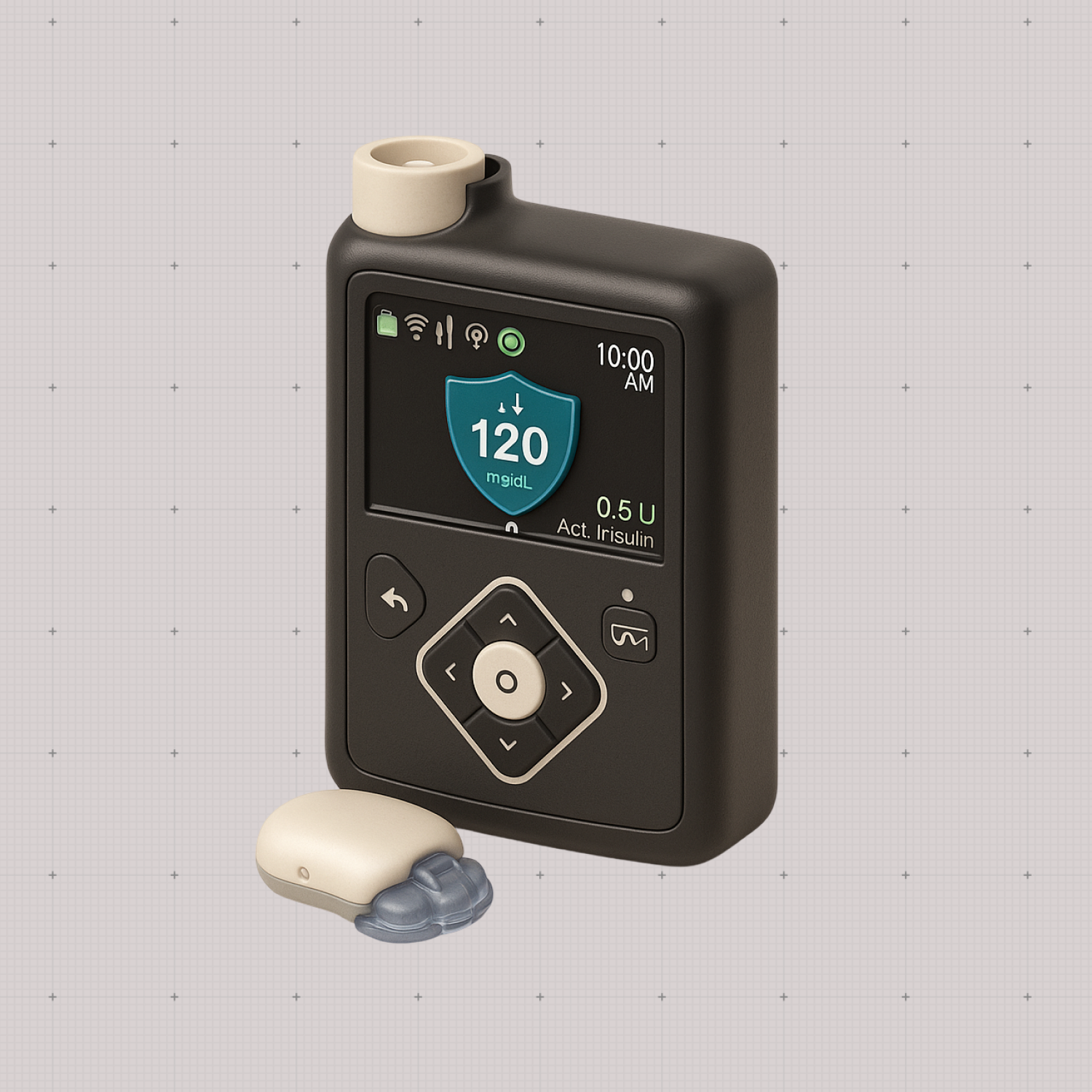
Checking out insulin pump options? Our simple guide breaks down your options, costs, and what to expect—so you can find the right fit for your life. Start your journey with confidence.
This guide is for information purposes only, and we encourage you to follow advice from your healthcare professional before making any decisions about your health.
An insulin pump is a device for people living with diabetes that eliminates the need to inject insulin by hand using a needle.
Insulin pumps are about the size of a deck of cards, attach to your body via tube or pod, and deliver insulin under the surface of the skin (subcutaneously). Insulin pumps help to relieve the burden of diabetes management by replacing the need to give many injections throughout the day.
Insulin pumps have been available for over 30 years, but have become more valuable and popular in recent years because the technology has continued to advance.
There are five commercially-available insulin pumps available on the market in Canada:
All insulin pumps listed above, with the exception of the Omnipod Dash, are Automated Insulin Delivery Systems. In Canada, automated insulin delivery (AID) refers to a system that uses a combination of devices and algorithms to automatically adjust insulin delivery based on real-time glucose readings. These systems are sometimes called “closed-loop” or “hybrid closed-loop” systems.
AID Systems Typically Include:
CGMs are an important tool that work alongside insulin pumps to help inform the pump – either automatically or through your own calculations – what actions to take.
Continuous glucose monitors like Dexcom’s G6 and G7, Freestyle’s Libre 2 and Medtronic’s Guardian sensors help to reduce the burden of diabetes management by providing ‘real-time’ information about how things like foods, exercise and stress affect blood sugars without having to poke your fingers all day to get a reading.
The sensors have a flexible filament that sits just below the surface of the skin and measures blood sugars every 1 to 5 minutes. CGMs use a transmitter that sends blood sugar readings to a smartphone or insulin pump using Bluetooth transmission that does not require internet (or wi-fi).
Insulin pumps work by delivering insulin to the body on frequent basis through an infusion set attached to the skin, usually on the belly, lower back, thigh or back of arm.
With an insulin pump, long-acting insulin is no longer needed; instead the pump delivers frequent, small doses of fast-acting insulin in response to the individuals needs and activities.
When eating meals or snacks, the pump user enters in a current blood sugar reading (not required with pumps that integrate with a CGM) and the amount of carbs being eaten. The pump then calculates the amount of insulin required based on settings programmed into the pump (e.g., basal rates, carb ratios, correction factor), and administers it automatically.
Insulin pumps have a changeable reservoir, cartridge or pod that contains enough insulin for a few days use. These need to be filled and maintained by the user who purchases and stores the insulin at home in vials.
Infusion sets come in a variety of sizes and configurations that suit different body types, skin types and preferences. Like CGM sensors, infusion sets are stickers that have a flexible cannula or tube that is inserted just under the surface of the skin. Insulin from the reservoirs or cartridges in the pump flows through the cannula of the infusion site into the body. Depending which pump you use and what kind of infusion set you choose, the infusion sets and reservoirs/cartridges need to be changed every 2-3 days with the exception of extended wear sites from certain brands that last 7 days.
Continuous glucose monitors like Dexcom’s G6 and G7, Freestyle’s Libre 2 and Medtronic’s Guardian sensors help to reduce the burden of diabetes management by providing ‘real-time’ information about how things like foods, exercise and stress affect blood sugars without having to poke your fingers all day to get a reading.
The sensors have a flexible filament that sits just below the surface of the skin and measures blood sugars every 1 to 5 minutes. CGMs use a transmitter that sends blood sugar readings to a smartphone or insulin pump using Bluetooth transmission that does not require internet (or wi-fi).
DIY Automated Insulin Delivery (AID), commonly known as “looping,” refers to open-source, user-built systems that automate insulin delivery by integrating insulin pumps, continuous glucose monitors (CGMs), and custom algorithms. Unlike commercial AID systems, DIY AID solutions are not officially approved by regulatory bodies but are developed and maintained by communities of people with diabetes and their supporters. Popular platforms include Loop (iOS), AndroidAPS, and OpenAPS.
In 2023, Diabetes Canada released a position statement and a healthcare provider guide acknowledging the growing use of DIY AID systems among Canadians with type 1 diabetes. The organization emphasizes that healthcare providers should support individuals in their choice of insulin delivery methods, including DIY AID systems, and provide guidance to optimize glycemic control and quality of life.
Observational studies have shown that DIY AID systems can lead to improved glycemic outcomes, reduced mental workload, and enhanced quality of life for users.
For individuals interested in exploring DIY AID systems, several community-driven resources are available:
Insulin pumps can make life with diabetes easier, but they’re not for everyone. Insulin pump therapy is available for children, adults and older adults on insulin with Type 1 or Type 2 diabetes. Talking to your healthcare team (e.g., endocrinologist, nurse, diabetes educator) may help you determine whether a pump is right for you. Doing your own research is also important to make sure you are making a choice that will support your lifestyle.
You may want to consider using an insulin pump if you:
Managing diabetes with an insulin pump requires the person living with diabetes to:
Some of the benefits of using an insulin pump include:
Most endocrinologists (doctors who specialize in diabetes) in Canada are supported by a Diabetes Education Program (DEP). Diabetes educators working with the DEPs can help people with diabetes to determine eligibility for insulin pumps. Criteria for eligibility includes:
Coverage for an insulin pump varies depending on the province you reside in. Most provinces have a financial assistance program that covers some – but not all – of the cost of using an insulin pump. Each program has different eligibility rules and requirements, but if you have type 1 diabetes there’s a good chance you will qualify.
Coverage requirements and amounts can change from time-to-time, so we encourage you to review the coverage and eligibility details directly on the official website. You’ll find the links here:
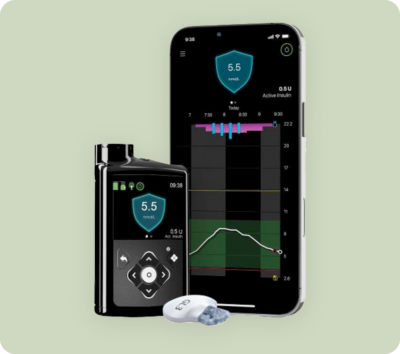
The Medtronic MiniMed™ 780G is an advanced hybrid closed-loop insulin pump available in Canada that automatically adjusts basal insulin and delivers correction boluses every five minutes, even for missed or underestimated meals. When paired with the Guardian™ 4 sensor, it operates without fingerstick calibrations and supports glucose targets as low as 5.5 mmol/L. It also features an extended infusion set option that lasts up to seven days. Compared to other pumps, like the Tandem t:slim X2 or Omnipod 5, the 780G offers more frequent auto-corrections and built-in meal detection.
Disclaimer: Prices are subject to change and pump prices are an estimated range only. For specific pump pricing please contact the manufacturer directly. Insulin pump and disposable insulin pump supplies may be covered under your provincial or private insurance plan(s) and direct billing may be available.
Pump: $1,200 to $8,000 depending on your current pump status and insurance. The pump can only be purchased directly from Medtronic
Monthly Supplies: $212 -$360 through Endor Health
Paired CGM: $385 to $400 per month
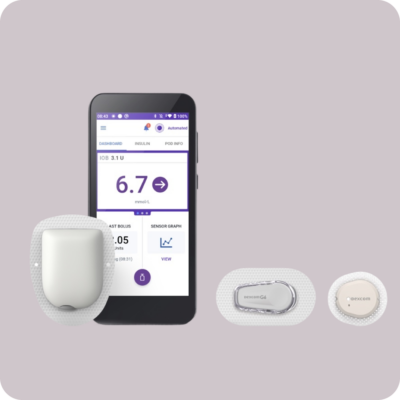
Omnipod 5 is the newest tubeless insulin pump available in Canada. The waterproof pod, worn for up to 3 days, can be placed directly on areas like the arms, legs, lower back, or stomach, giving users options for comfort and discretion. Without tubing to manage or get caught on clothing, it can feel less intrusive and easier to wear during daily activities like sleeping, exercising, or getting dressed.
The system adjusts insulin automatically based on glucose readings from either the Dexcom G6 or the Dexcom G7, helping reduce the effort of diabetes management. The pod’s settings are controlled using a handheld controller, but the pod and Dexcom sensor communicate directly with each other so that automated insulin delivery is not disrupted if the handheld controller is out of range. For many people, it offers a greater sense of freedom and flexibility compared to traditional pumps and may be the best option for people who refuse an insulin pump due to the tubing.
Note: Prices are subject to change. Controller and disposable insulin pump supplies may be covered under your provincial or private insurance plan(s) and direct billing may be available.
Handheld controller: $650 – $6300 depending on whether you’re currently on a pump or not. The controller can only be purchased from Insulet Canada directly.
Disposable Supplies: $334/box of 10 pods (Per month based on a pod change every 3 days)
Dexcom sensors: ~$260 – $299 per month through Endor Health
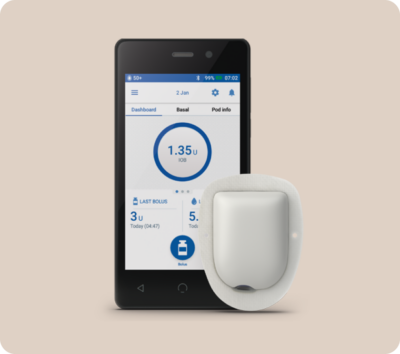
The Omnipod DASH® is a tubeless, waterproof insulin pump system available in Canada, offering up to 72 hours of continuous insulin delivery through a discreet, wearable Pod. Controlled wirelessly via a touchscreen Personal Diabetes Manager (PDM), it simplifies diabetes management with customizable basal and bolus settings, eliminating the need for daily injections and tubing.
The Pod is small, wireless, and worn directly on the body—no tubing, nothing clipped to your belt. It’s easy to hide under clothing and feels less “medical,” which many users love.
The Omnipod DASH features a built-in, automated insertion mechanism—just press a button and the cannula inserts in seconds. No needles in sight, no manual steps, and much less anxiety for many users.
However, it’s important to note that the Omnipod DASH does not feature automated insulin delivery; it requires users to manually adjust insulin doses based on their glucose readings. For those seeking automated insulin delivery, the Omnipod 5 system offers this functionality and has been approved by Health Canada.
Note: Prices are subject to change. The Personal Diabetes Manager (PDM) and disposable insulin pump supplies may be covered under your provincial or private insurance plan(s) and direct billing may be available.
PDM (handheld controller): $650 – $6300 depending on whether you’re currently on a pump or not. The controller can only be purchased from Insulet Canada directly.
Disposable Supplies: $290 – $300/box of 10 pods (Per month based on a pod change every 3 days)
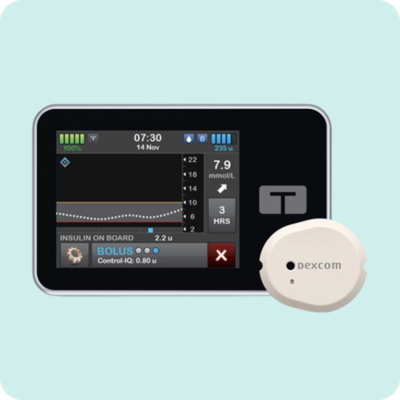
The Tandem t:slim X2™ is a sleek, touchscreen insulin pump available in Canada that combines advanced technology with a user-friendly design.
Powered by Control-IQ™ technology, it integrates with continuous glucose monitors like the Dexcom G6 and G7 to predict glucose levels 30 minutes ahead and automatically adjust insulin delivery, including administering correction boluses when necessary. It helps smooth out highs and avoid lows, especially overnight and after meals. Users can personalize their therapy with customizable profiles and activity settings for sleep or exercise, and conveniently bolus from their smartphone using the t:connect mobile app .
Additionally, the pump supports remote software updates, ensuring access to the latest features without the need for a new device. It’s one of the slimmest pumps on the market, with a full-color touchscreen and a look that feels more like a modern device than a medical tool. Plus, no battery changes—just plug in to recharge.
Note: Prices are subject to change and pump prices are an estimated range only. For specific pump pricing please contact the manufacturer directly. Insulin pump and disposable insulin pump supplies may be covered under your provincial or private insurance plan(s) and direct billing may be available.
Pump: ~$1000 – $6300 depending on whether you’re currently on a pump or not. The pump can only be purchased from Tandem directly.
Disposable Supplies: $220 -$250 per month through Endor Health
Dexcom sensors: ~$260 – $299 per month through Endor Health

The mylife Loop system, combining the Ypsomed YpsoPump with the CamAPS FX app, offers an advanced automated insulin delivery (AID) solution for Canadians with type 1 diabetes. This hybrid closed-loop system integrates with Dexcom G6, adjusting insulin delivery every 8–12 minutes based on real-time glucose readings.
Users appreciate its adaptive algorithm that learns individual insulin needs, the convenience of managing therapy via smartphone, and the “Companion remote monitoring” feature, which allows caregivers to monitor glucose and insulin data remotely, providing peace of mind. Many report improved glycemic control, reduced daily management burden, and enhanced quality of life, especially for families with young children.
Note: Prices are subject to change and pump prices are an estimated range only. For specific pump pricing please contact the manufacturer directly. Insulin pump and disposable insulin pump supplies may be covered under your provincial or private insurance plan(s) and direct billing may be available.
Pump: $6000 – $6500 for new pump users
Disposable Supplies: $235 – $290 per month through Endor Health
Dexcom sensors: $299 plus transmitter for Dexcom G6 through Endor Health
The choice of insulin pump depends on individual preferences, lifestyle, and medical needs. Factors such as tubing, reservoir size, automation features, CGM compatibility, and mobile app control should be considered when selecting a pump. For more detailed information please reach out to a Diabetes Educator/Certified Pump Trainer in the care section of the Endor health app.